A Legendary Truck Goes Electric
It has finally happened — the Toyota Hilux, one of the most durable and globally recognized pickup trucks, has entered the electric era. The ninth-generation Hilux made its debut in Thailand, marking a major milestone for Toyota as it embraces electrification in its iconic workhorse lineup.
This launch comes a full decade after the previous generation, and the spotlight now shines on the battery-electric variant, which precedes the diesel, mild-hybrid, and hydrogen versions still to come.

Design and Configurations
The new Hilux BEV will be available in both single- and double-cab body styles. However, Toyota confirmed that European markets will only receive the double-cab model, citing stronger sales potential and consumer preference for practicality and versatility.
Stylistically, the ninth-generation model adopts a bolder and more modern stance, borrowing design elements from the Land Cruiser and Tacoma. The front end features a wide grille and squared-off LED headlights, while the cabin boasts a robust interior layout with two 12.3-inch digital displays — one for the instrument cluster and one for infotainment.
Electric Powertrain and Performance
Under the hood — or rather, beneath the chassis — the Hilux BEV runs on a 59.2-kWh battery pack paired with dual electric motors, one mounted on each axle. The combined output reaches 193 horsepower (144 kW), with 151 lb-ft (205 Nm) of torque delivered by the front motor and 198 lb-ft (269 Nm) from the rear.
This setup provides genuine four-wheel-drive capability while maintaining the Hilux’s traditional toughness. The payload capacity is rated at 1,576 lbs (715 kg), and the towing limit reaches 3,527 lbs (1,600 kg) — more than adequate for most light commercial or agricultural tasks.
Range and Charging
The most notable limitation of the new Hilux BEV is its driving range. Toyota estimates around 150 miles (240 kilometers) on a full charge under the WLTP testing cycle. While modest by today’s EV standards, Toyota argues this is ideal for daily short-distance work, particularly in urban areas, construction sites, and farms.
The battery pack sits between the ladder-frame rails, a placement that keeps the center of gravity low and preserves cabin space. Toyota has not yet disclosed charging speed or DC fast-charging capability, and the official images only show the truck connected to a Level 2 charger.
Interior Tech and Driving Experience
Inside, the Hilux EV combines traditional practicality with a touch of modernization. Toyota retained physical buttons for key controls, catering to drivers who value simplicity and durability in harsh environments.
For the first time in Hilux history, the pickup features electric power steering, improving maneuverability at low speeds. The infotainment system supports over-the-air updates, signaling Toyota’s commitment to long-term digital support.
Beyond Electric: Diesel and Hydrogen Options
While the BEV version takes center stage, Toyota is not abandoning traditional powertrains. The lineup will include:
-
A 2.8-liter turbodiesel with mild-hybrid technology
-
A 2.8-liter non-hybrid diesel
-
A 2.7-liter gasoline engine, depending on market availability
Looking further ahead, a hydrogen fuel-cell (FCEV) Hilux is planned for 2028, as Toyota continues to explore alternative clean energy pathways.

Market Launch and Availability
The Hilux BEV will arrive in European showrooms this December, followed by the mild-hybrid diesel variant in spring 2026. While global markets will benefit from the electric Hilux, North America will likely miss out, as Toyota’s Tacoma continues to serve that segment — albeit without an electric option for now.
Recommend Reading: Toyota’s Solid-State Battery Could Redefine the Future of EVs








Partager:
Best EV Lease Deals and Financing Offers in November 2025
Tesla Semi Unveils Futuristic Redesign Ahead of Delayed Mass Production